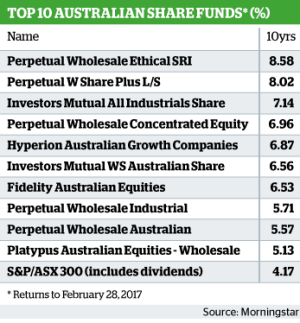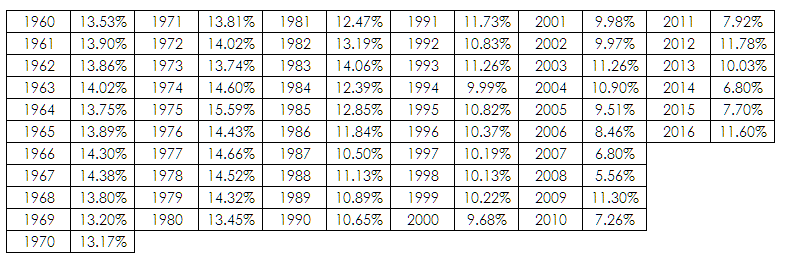It is no secret that I am not a fan of fund managers of any kind, be they the more exotic style of hedge fund that exists as an idiot tax for those who invest in them, the standard vanilla equity investment fund or the legally mandated rip off that are superannuation funds. My objection is simple, if you are going to take billions in fees from people then you had better deliver something other than perpetually under performing the market. In a puff piece that looked somewhat like a marketing exercise Morningstar the ratings agency has named the top investment funds in Australia and the list was picked up by Fairfax and covered here. I have copied the list of top funds below.
Source – Fairfax
The article talks about the value of investing in the number one ranked fund since it has outperformed the index over the last 10 years – this point got me thinking about using 10 years as a point of comparison and the notion of starting points in general. As a general point I find selecting 10 years interesting since it makes certain that the funds are compared against the index during and post the GFC and it doesn’t take a genius to work out that the average return from the index since that time has been poor.
I decided to have a deeper look at the impact of starting times upon portfolios by digging up some data on the All Ordinaries Accumulation Index which is now referred to as Total Return Index since it includes the return from both gains in the index and dividends. Starting in 1960 I looked at what your average return would be to the present day if you had started investing at a given point. For example if you had invested in an index linked fund in 1960 your average return up until the present date would have been 13.53% whereas if you had begun your investment journey in 1994 your average return would be 9.99%. This might not seem to be a substantive difference but over time it adds up to a small fortune.
What interested me when I looked at this data was the remarkably consistent nature of the returns – they are all positive. Whilst, this is to be expected it is nonetheless interesting that the index doesn’t put together strings of negative years and this is shown in the raw data that I will look at later. What is also evident is that there seems to be a tailing off in average returns which is more obvious when this data is plotted as a chart.
The reason for this drop off can be found in the raw data as shown below. This data is the true return for the index for each year in the sample.
In this table I have highlighted each year where the return was over 25%. You can see a cluster of such returns in the 1970’s and 1980’s with a drop off in 1990 and 2000 and since 2010 there has not been such a year. In performance outliers count disproportionately and when they are lacking things look bleaker. I have no real explanation as to the rationale for the drop off in returns although I would surmise it may be simply due to a lack of funds flowing into the market due to the real estate boom. My recollection of the lift in 1991 and 1993 where due in part to the pent up recovery in the market post the 1987 crash but also that real estate struggle under the regime of high interest rates so we had an asset rotation underway.
Despite this drop off in returns over the past decade there is still no compelling reason to buy a managed fund. However, it is important to note that these are average returns over deep time – it in no way diminishes the importance of not being in the market when the market has nothing to give you. What also amazes me about fund managers is that they believe timing is so hard when in fact with simple mechanical rules it is remarkably easy as I have already demonstrated here using the ETF STW. Trading is only as hard as you make it or in the case of fund managers it is only as hard as you want to make it appear.










